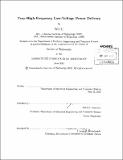| dc.contributor.advisor | David J. Perreault. | en_US |
| dc.contributor.author | Li, Wei, Ph. D. Massachusetts Institute of Technology. Department of Electrical Engineering and Computer Science | en_US |
| dc.contributor.other | Massachusetts Institute of Technology. Department of Electrical Engineering and Computer Science. | en_US |
| dc.date.accessioned | 2013-11-18T19:12:27Z | |
| dc.date.available | 2013-11-18T19:12:27Z | |
| dc.date.copyright | 2013 | en_US |
| dc.date.issued | 2013 | en_US |
| dc.identifier.uri | http://hdl.handle.net/1721.1/82352 | |
| dc.description | Thesis (Ph. D.)--Massachusetts Institute of Technology, Dept. of Electrical Engineering and Computer Science, 2013. | en_US |
| dc.description | Cataloged from PDF version of thesis. | en_US |
| dc.description | Includes bibliographical references (p. 217-223). | en_US |
| dc.description.abstract | Power conversion for the myriad low-voltage electronic circuits in use today, including portable electronic devices, digital electronics, sensors and communication circuits, is becoming increasingly challenging due to the desire for lower voltages, higher conversion ratios and higher bandwidth. Future computation systems also pose a major challenge in energy delivery that is difficult to meet with existing devices and design strategies. To reduce interconnect bottlenecks and enable more flexible energy utilization, it is desired to deliver power across interconnects at high voltage and low current with on- or over-die transformation to low voltage and high current, while providing localized voltage regulation in numerous zones. This thesis introduces elements for hybrid GaN-Si dc-de power converters operating at very high frequencies (VHF, 30-300 MHz) for low-voltage applications. Contributions include development of a new VHF frequency multiplier inverter suitable for step-down power conversion, and a Si CMOS switched-capacitor step-down rectifier. These are applied to develop a prototype GaN-Si hybrid dc-dc converter operating at 50 MHz. Additionally, this thesis exploits these elements to propose an ac power delivery architecture for low-voltage electronics in which power is delivered across the interconnect to the load at VHF ac, with local on-die transformation and rectification to dc. With the proposed technologies and emerging passives, it is predicted that the ac power delivery system can achieve over 90 % efficiency with greater than 1 W/mm² power density and 5:1 voltage conversion ratio. A prototype system has been designed and fabricated using a TSMC 0.25 [mu]m CMOS process to validate the concept. It operates at 50 MHz with output power of 4 W. The prototype converter has 8:1 voltage conversion ratio with input voltage of 20 V and output voltage of 2.5 V. To the author's best knowledge, this is the first ac power delivery architecture for low-voltage electronics ever built and tested. | en_US |
| dc.description.statementofresponsibility | by Wei Li. | en_US |
| dc.format.extent | 223 p. | en_US |
| dc.language.iso | eng | en_US |
| dc.publisher | Massachusetts Institute of Technology | en_US |
| dc.rights | M.I.T. theses are protected by
copyright. They may be viewed from this source for any purpose, but
reproduction or distribution in any format is prohibited without written
permission. See provided URL for inquiries about permission. | en_US |
| dc.rights.uri | http://dspace.mit.edu/handle/1721.1/7582 | en_US |
| dc.subject | Electrical Engineering and Computer Science. | en_US |
| dc.title | Very-high-frequency low-voltage power delivery | en_US |
| dc.type | Thesis | en_US |
| dc.description.degree | Ph.D. | en_US |
| dc.contributor.department | Massachusetts Institute of Technology. Department of Electrical Engineering and Computer Science | |
| dc.identifier.oclc | 861743289 | en_US |
